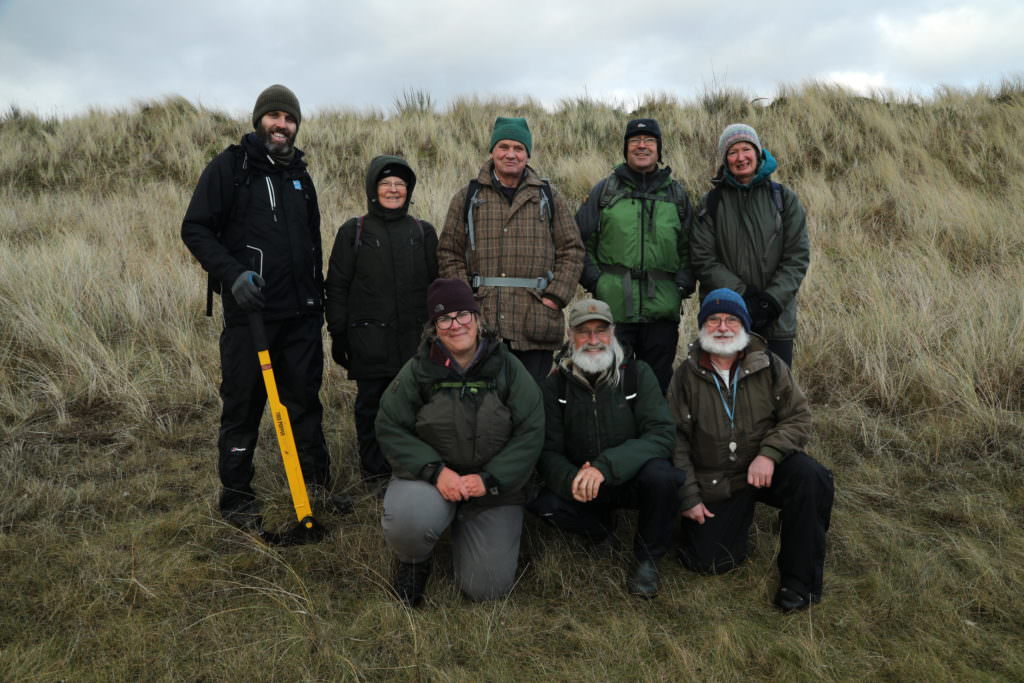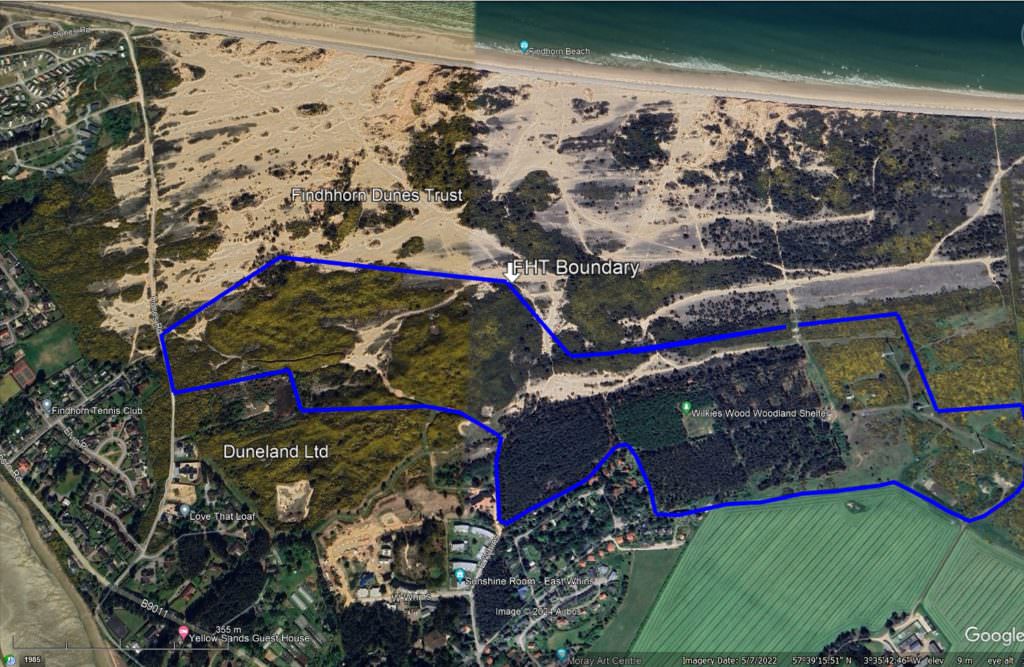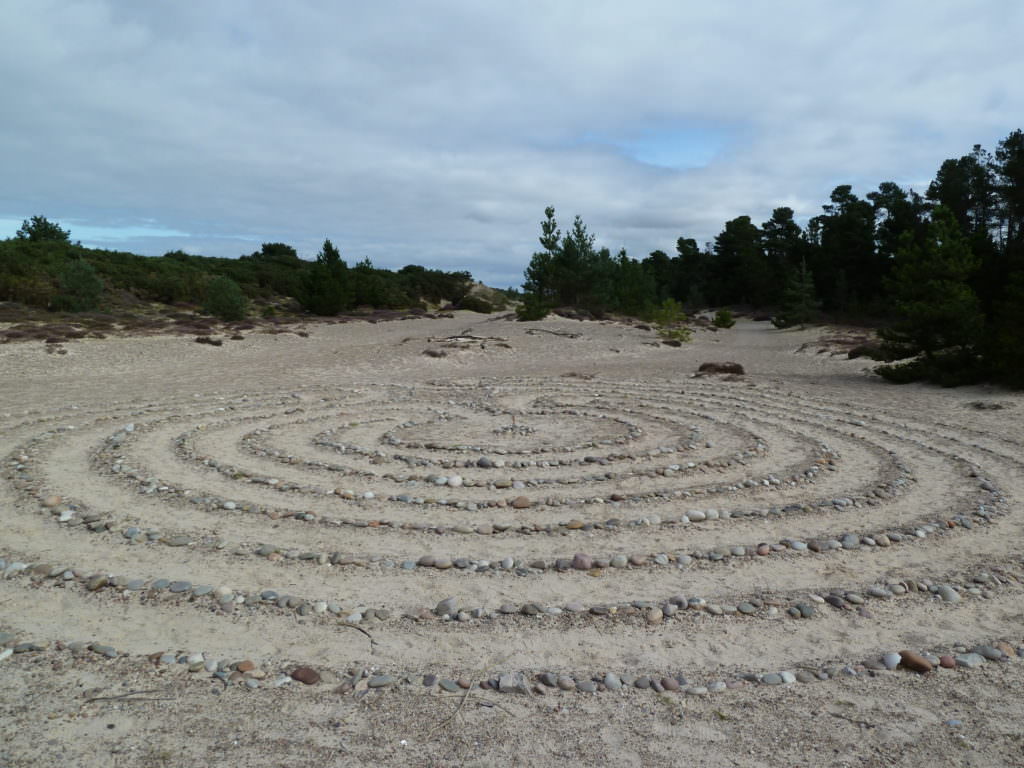We had a very helpful meeting with the RSPB at their Culbin Sands nature reserve in November. Site Manager Steph Elliot and Project Officer David Tompkins showed us the work they are doing to protect threatened sand dune habitats and species through removing scrub and small trees. It is important to emphasise that trees do not occur naturally in sand dune habitats. They have arrived from seeds blown-in from nearby forestry plantations and are able to get established due to the wind-sheltering effect of the plantations. Once they do establish, they further reduce wind speeds, establishing a negative feedback loop which, if unchecked, results in the loss of extremely rare dune habitats and the threatened species they provide a home for – some of which are described in Alan Watson Featherstone’s article. You can read more about the RSPB’s work in their article. Many thanks to Steph and David for their time and support!

Group visit to Culbin. L-R David Tompkins, Heather Paul, Steph Elliot, Jonathan Caddy, Kajedo Wander, Sean Reed, Alan Watson Featherstone, Carla Hornsby. Photo by Alan Watson Featherstone
We have also had some very helpful meetings with our neighbouring charity, the Findhorn Dunes Trust, which owns the dunes to the north of the Hinterland area. Being further away from the wind-sheltering effect of trees and houses, this area is in better ecological condition than the Hinterland area, which is mainly covered in gorse. But trees are spreading rapidly on the open dunes and urgent action is needed.
Both Trusts have been carrying-out scrub removal work for years, using hand tools and work parties. The focus of current discussions is how we can step this up and make a real difference for our local biodiversity, before it’s too late. We know that this is beyond the capacity of work parties and that contractors with specialist equipment will be required. You can read more about the need for scrub removal, and the techniques used, in Tracy Munroe’s article (Butterfly Conservation).
We were excited to be invited to apply for a substantial grant which would have paid for the contractor work. Unfortunately, it is now looking like the grant is no longer available. Still, nothing has been lost, as preparing for the grant helped us plan the project and we are now looking at other potential funding opportunities.

FHT boundary, showing the extent of gorse cover
The focus is now on connecting the Hinterland’s few remaining sandy areas through opening-up corridors through the gorse and allowing the elemental force of the wind to regenerate the natural process of sand movement. The Dune Managers Handbook (Dynamic Dunescapes 2021) tells us that healthy dune ecosystems have around 4% scrub (gorse). Aerial photos show us that the dunes within the Hinterland area are covered with around 90% of gorse. Reinvigorating the ecosystem here is an exciting prospect, especially during a period when so many other changes are happening with the adjoining Park Ecovillage.

Spiral
Sean Reed
Ecologist
February 2024

Dune Restoration Project Update
We had a very helpful meeting with the RSPB at their Culbin Sands nature reserve in November. Site Manager Steph Elliot and Project Officer David Tompkins showed us the work they are doing to protect threatened sand dune habitats and species through removing scrub and small trees. It is important to emphasise that trees do not occur naturally in sand dune habitats. They have arrived from seeds blown-in from nearby forestry plantations and are able to get established due to the wind-sheltering effect of the plantations. Once they do establish, they further reduce wind speeds, establishing a negative feedback loop which, if unchecked, results in the loss of extremely rare dune habitats and the threatened species they provide a home for – some of which are described in Alan Watson Featherstone’s article. You can read more about the RSPB’s work in their article. Many thanks to Steph and David for their time and support!
Group visit to Culbin. L-R David Tompkins, Heather Paul, Steph Elliot, Jonathan Caddy, Kajedo Wander, Sean Reed, Alan Watson Featherstone, Carla Hornsby. Photo by Alan Watson Featherstone
We have also had some very helpful meetings with our neighbouring charity, the Findhorn Dunes Trust, which owns the dunes to the north of the Hinterland area. Being further away from the wind-sheltering effect of trees and houses, this area is in better ecological condition than the Hinterland area, which is mainly covered in gorse. But trees are spreading rapidly on the open dunes and urgent action is needed.
Both Trusts have been carrying-out scrub removal work for years, using hand tools and work parties. The focus of current discussions is how we can step this up and make a real difference for our local biodiversity, before it’s too late. We know that this is beyond the capacity of work parties and that contractors with specialist equipment will be required. You can read more about the need for scrub removal, and the techniques used, in Tracy Munroe’s article (Butterfly Conservation).
We were excited to be invited to apply for a substantial grant which would have paid for the contractor work. Unfortunately, it is now looking like the grant is no longer available. Still, nothing has been lost, as preparing for the grant helped us plan the project and we are now looking at other potential funding opportunities.
FHT boundary, showing the extent of gorse cover
The focus is now on connecting the Hinterland’s few remaining sandy areas through opening-up corridors through the gorse and allowing the elemental force of the wind to regenerate the natural process of sand movement. The Dune Managers Handbook (Dynamic Dunescapes 2021) tells us that healthy dune ecosystems have around 4% scrub (gorse). Aerial photos show us that the dunes within the Hinterland area are covered with around 90% of gorse. Reinvigorating the ecosystem here is an exciting prospect, especially during a period when so many other changes are happening with the adjoining Park Ecovillage.
Spiral
Sean Reed
Ecologist
February 2024